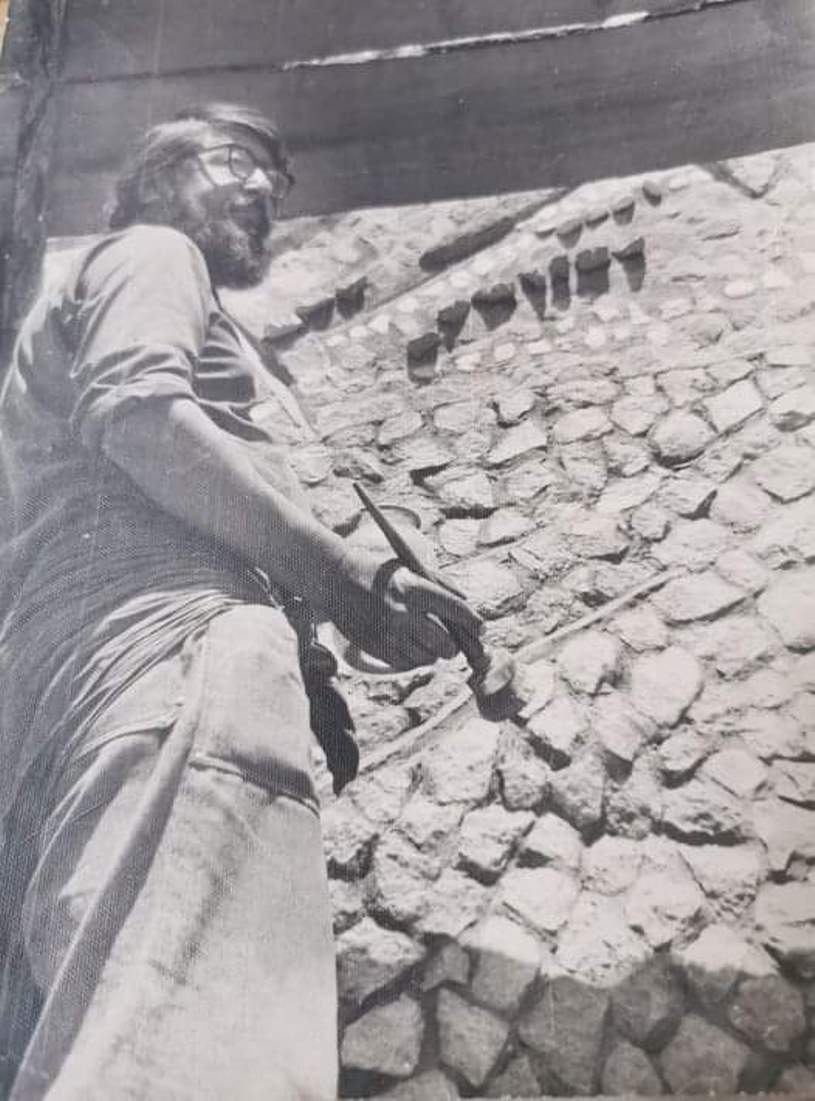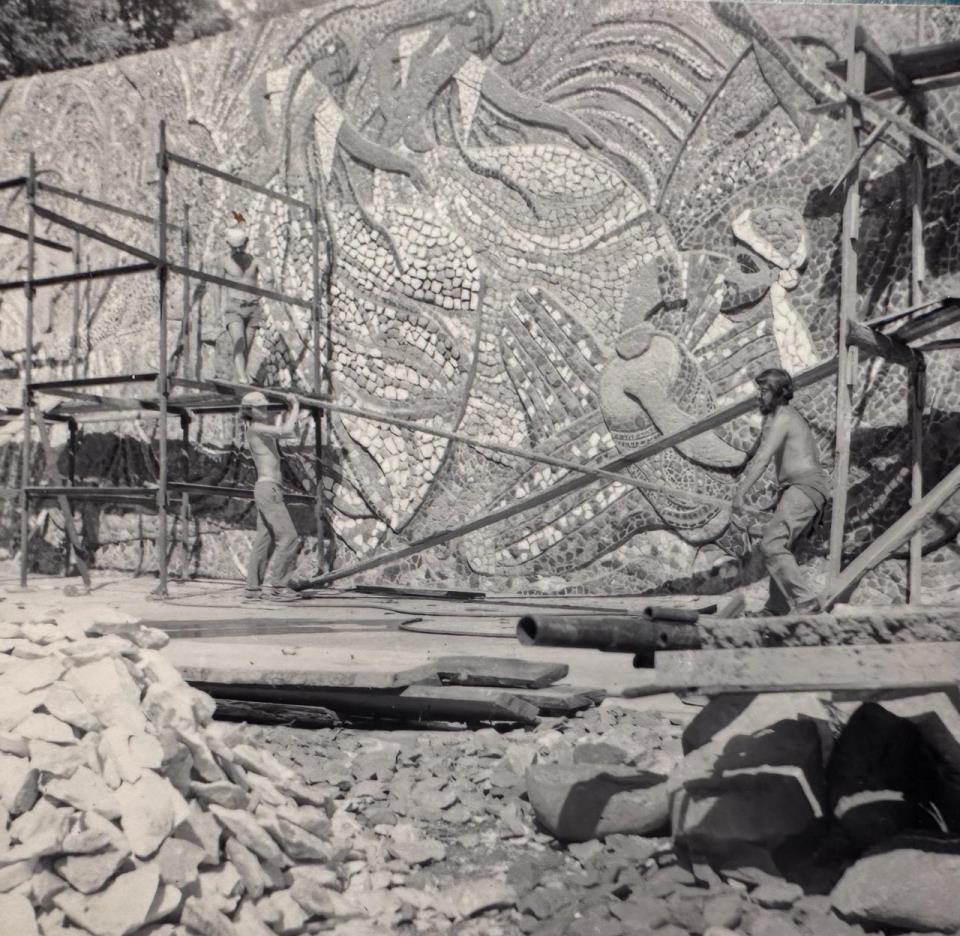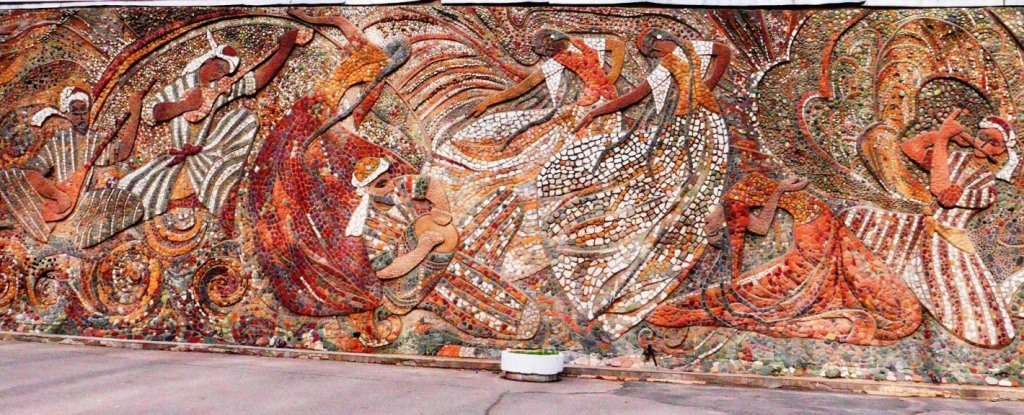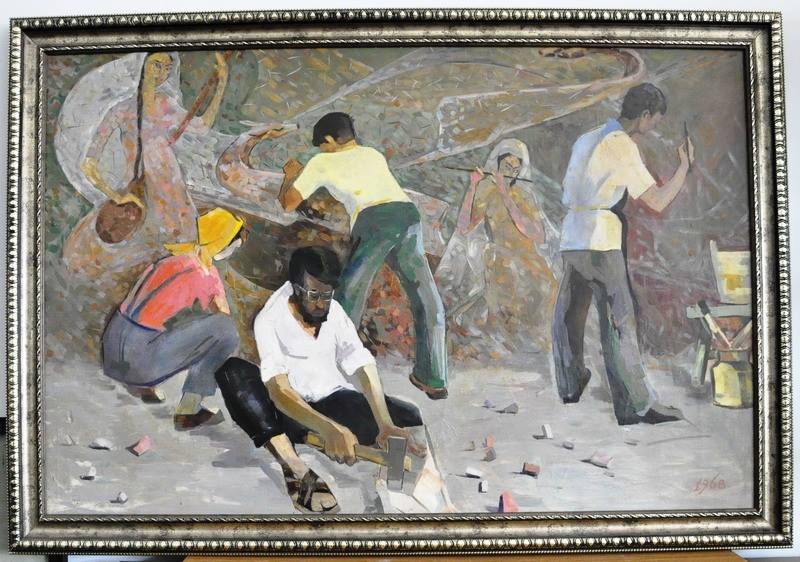To begin with, we recall that the Chairman of Dushanbe has already given instructions to preserve the historical mosaic for future generations, and an international team of experts restorers has already begun work.
So who is he, the author of this mosaic, the artist Asror Aminjanov? What kind of person was he, how did he get into art and why is it important to preserve his legacy?
We decided to tell "Asia Plus" readers about this, but it turned out that there is almost no information about this person in the public domain. We had to literally piece together the facts about Aminjanov's life and work - we talked with the artist's students and associates, with people who knew him well, we found the children of the master in St. Petersburg - Marifat and Temur Aminjanov.
As the result we have this story.
Choosing a profession
Asror Aminjanov was born in winter of 1930 in Dushanbe, he was the 7th child in priest family, Mullo Toshpulat. According to the artist's daughter Marifat, domullo Toshpulat went to Dushanbe from neighboring Uzbekistan, fleeing from the Soviet government, which was setting its own new rules in Turkestan.
The upbringing in the family of the former mullah was strict, sometimes cruel. According to the stories of the artist's daughter Marifat, one day domullo Toshpulat, suspecting his son of theft, nailed him by the ear to a tree in the courtyard of his house.
Father spoke about this terrible punishment with gratitude, showing the children their grandfather’s portrait, which always hung in their Dushanbe house on Omar Khayyam Street, 13.
"Father said that it was this trauma that turned him away from bad thoughts and deeds once and for all...", says Marifat.
According to the artist's son, Temur, his grandfather Toshpulat did not approve of his son's choice of profession, nevertheless, the artist remained faithful to his chosen profession.
His career as an artist began at the Dushanbe Art College. Here, noticing his talent, the young man, along with three other students, was sent to study at the Leningrad Industrial and Art College named after V.I. Mukhina (now St. Petersburg State Art and Industrial Academy named after A.L. Stieglitz.).
"My father's studies in Leningrad fell during the difficult post-war years in a city that had only recently survived the blockade. He told how, as a student, he starved and looked for any opportunity to find food, earned what he could. He even taught dancing...", says Temur.
There the young artist met his future wife Lyudmila Gevorskaya, with whom they later left for the Tajik capital. Asor's father did not support his son here either - he did not approve of the choice of his betrothed. Therefore, the young spouses also did not have financial support from their parents.
"The young artist could not find a job for a long time, since he rejected the most common orders at that time - to paint portraits of Lenin, considering such a "craft" unacceptable to himself. My father was and remains a creator beyond time and politics. He devoted his talent and his whole life to the art and culture of Tajikistan, loved and knew Pamir mountains, walked and explored many passes and peaks in search of the right rocks," says Temur Aminjanov.
"Hands in endless abrasions and scars"
Asror Aminjanov gradually moved from painting to monumental works made of stone mosaics.
He did not receive orders from the state, as they were mainly related to ideological topics. But friends helped Asror as much as they could.
"One of the admirers of his talent was the head of a construction company. This is how a series of bus stops, monumentally decorated with its mosaics, appeared. My father said: "Stone and concrete are eternal materials. My art will go down into eternity with my people," his son recalls his words.
Temur Aminjanov remembers his father's hands "in endless abrasions and scars." Creating a stone mosaic is a hell of a job.
As Temur says, dozens of tons of various stones of different colors were collected in the mountains and transported in ordinary duffel bags for hundreds of kilometers along mountain trails.

"Hundreds of shades of color were needed in the mosaic, and each one had to be found, guessed the color in a river boulder, smashed with an ordinary hammer and brought to the valley on the shoulders," Temur notes.
Even student interns and workers could not stand such hellish work and often refused to work.
"This is how my father's mosaics were born, with which he decorated his beloved republic and the city of Dushanbe," says Timur Aminjanov.
Marifat recalls that many creative people used to visit their Dushanbe house on O.Khayyam Street:
"My father was friends with scientists, ballerinas, writers, and artists. Timur Zulfikarov, Malika Sabirova, Sabzali Sharipov, Lutfiya Aini and many others visited our house. The main idea uniting all these people was a sincere desire to serve people."

According to her, her father often received offers for the design of private houses and fountains, but he did not fulfill any private orders, believing that art should serve the people…
"The Father of stone mosaics"
One of those who remembers "usto Asror" is the People's Artist of Tajikistan, the famous muralist Sabzali Sharipov. He studied with a young teacher at the M.Olimov Art College.
At the school, he led 2 departments – textile and decorative design and in a few years he trained more than 80 students, film artist Manzura Uljabayeva notes in her article. Asror Aminjanov introduced a lesson in stone mosaics into the training program.
Sabzali Nigmatovich remembers the teacher and his generation of artists as the generation "breaking stereotypes" of those times.
"The first thing they have introduced into the modern architecture of Tajikistan is monumental art. Asror Aminjanov was the "father of stone mosaics" made of natural stone. Not everyone understood this kind of art then, they tried to "put a spoke in the wheels." Because his compositions did not correspond to the stereotypes and ideological requirements of that time," recalls Sabzali Nigmatovich.
He learned a lot from his teacher. The students were not only taught theory, but also they were involved in practical work. One of these works is a mosaic on the facade of the cinema "Norak" in the city of Nurek. It is also one of Aminjanov's first works.

"It was a large stylized nude male figure. We helped him create this mosaic. Not everyone then perceived this creation - they thought, how can it be, a naked body! There was very strict censorship back then. But after this mosaic was recognized as the "largest mosaic", his opponents were forced to accept. After that, the road opened for Asror Toshpulatovich as an artist," recalls Sabzali Sharipov.
Later, Aminjanov worked on the mosaic "Walking Tiger" (it has not been preserved) on the descent down Putovsky Street, his work decorated the facade of "Javonon" summer cinema, the buildings of the "Tajikfilm" film studio and others.
Asror Aminjanov's creations could also be seen at bus stops, from where shuttle buses left for Fakhrobad, Khorog, Kurgan-Tube and other settlements.

On the way to Rasht district there is a "Spring of Poets", where Aminjdanov created an entire architectural ensemble, which took him about 5 years…
"Under the guidance of Asror Toshpulatovich, I completed my thesis "The Uprising of Vose" (1967), a fragment of the portrait of Vose. Then I left to go to college in Tashkent. When he returned after the entrance exams, he was working on a sketch of "Shashmaqom" mosaic, it was an order from the Ministry of Culture. At that time, he did not go into details about where it would be: he was a superstitious person and did not like to talk about work ahead of time.
Usto Asror is also remembered by another of his students, Juma Abduraufov, who was able to enter the art school in Dushanbe thanks to him. In 1967, he and a friend came to enroll in the painting department there. One of the teachers who got acquainted with the works of young applicants was Asror Aminjanov.

After seeing the drawings of Juma and his friend Hassan Dzhumaev, the teacher invited them to practice in Takob mountains and they immediately agreed. There they had to prepare for admission. Asror Aminjanov taught future students not only art, but also life.
"As a teacher, he was not strict - before giving a task, he explained in detail how to prepare, and then did not forget to check. We remember him for his honesty, fairness and hard work," recalls Juma Abduraufov. - We sometimes went to draw sketches in the mountains and lived in tents, there, Asror Aminjanov, in addition to monumental works, painted in watercolor, collected rare stones for mosaics.We, his students, tried to adopt his diligence and punctuality…".

"When the master surpassed himself"
Sabzali Sharipov believes that "Shashmaqom" mosaic turned out to be very rhythmic and plastic in its style. The modulus (size of the stone) and shape are of great importance in mosaic.
"In Aminjanov's previous works, stones did not have such a rhythmic sound. We can say that Asror Toshpulatovich has surpassed himself here," says Sabzali Sharipov. The artist's daughter Marifat says that the co–author of "Shashmaqom" mosaic was also her mother Margarita Skrepleva, the artist's second wife.
At that time, all artists’ works passed through the censorship of the Central Committee, even the names of the works were agreed upon. "Shashmaqom" was considered Uzbek art and the leadership was against this name, but Asror Aminjanov had a different opinion.
"He said, "Shashmaqom" is the property of the whole world, it's a Persian word, so I called this mosaic "Shashmaqom". By doing this he showed what a patriotic artist he was," Sabzali Nigmatovich notes.

"Shashmaqom" is the first monumental work in Tajik architecture created by a professional artist, says Sabzali Sharipov.
Asror Aminjanov collected a whole palette of stones of different colors and compiled a map that indicates in which regions which stone lies.
The value of "Shashmaqom" mosaic is also noted by the son of its author. "My father's works were timeless and opportunistic, so they were not adequately appreciated during his lifetime. He did not create a single image of Lenin or Marx. But his dancing girls and boys on this mosaic, as if alive, only froze for a moment to the sounds of national music.
"Shashmaqom" is an ingenious work embodying an immeasurable love for the people of the republic, their hard working life. National music and beautiful folk dances are the true face of the people and the father imprinted them for future generations. So that they preserve their cultural identity and do not become slaves of foreign cultures," says Temur Aminjanov.
"Preserve our heritage!"
According to experts and activists of the Tajik society, it is important to extend the initiative of the mayor of Dushanbe to preserve the "Shashmaqom" mosaic to other works of monumental art of the Tajik capital and the whole country.
"Monumental art lives for a long time and is accessible to everyone, which is why it differs from easel art, the works of which can only be seen at exhibitions or in salons. The mosaic is always available to the viewer, it is constantly seen by thousands of eyes. These are works of art that "live" directly in the architecture of the city - on facades, in the interior of buildings, - says the chairman of the Union of Artists Nargis Khamidova, - And therefore monumental art should not be forgotten. We need to preserve what we inherited and what we will not be ashamed to pass on to the next generations."
In Tajikistan, she notes, monumental and decorative art developed very successfully in the 70s and 80s of the last century.
In this area, the first successes were associated with the name of the muralist Asror Aminjanov.

"And "Shashmaqom" has always been considered one of the most significant works of the artist. Today, this mosaic is recognized as one of the masterpieces of monumental art of our country," Nargis Khamidova adds.
The importance of preserving such creations is also noted by Asror Aminjanov's daughter, Marifat. She followed in her father's footsteps and became a designer, graduating from the A.L. Stieglitz State Academy of Art and Industry in St. Petersburg.
"In 2014, I visited Tajikistan, visited and photographed all the preserved objects made by my father, located in different regions of Tajikistan. Some mosaics were damaged by mudslides, and at one of the stops I saw black soot - echoes of the terrible military events in Tajikistan. But there were also excellent examples when my father's work was well preserved. The mosaic panel "Shashmaqom" is one of them," says Marifat.
"I pray and ask the people on whom such decisions depend, on behalf of all my sisters and brothers living in Tajikistan and beyond, to leave a wonderful memory of history in the form of a cultural heritage object of "Shashmaqom" mosaic for the grandchildren and grandchildren of our grandchildren."
The painting "Creators of Beauty", made by an artist-painter from Tajikistan named Bayskikh, is dedicated to the Work of Asror Aminjanov.

The "People's Artist"
Usto Asror continued to create until his last days of his life. He died in 1990 of a heart attack while working in his workshop.…
Despite all his numerous artistic works, Asror Aminjanov never received the title of "People's Artist". Nevertheless, he will remain in Tajik history and national memory precisely as a "national artist", whose works can still be admired by thousands of ordinary people.







